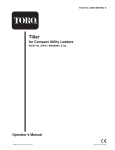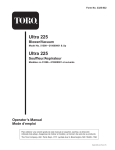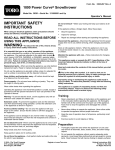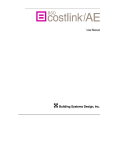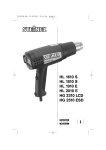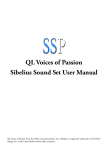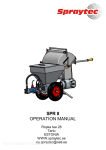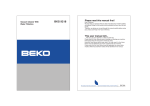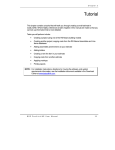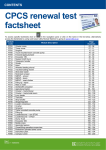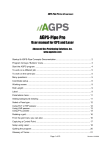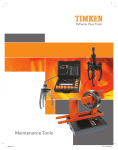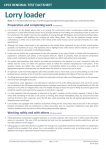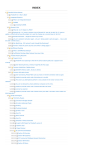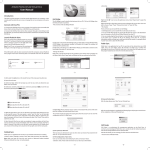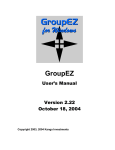Download Vibratory Plow – Attachment
Transcript
Form No. 3364-936 Rev A Vibratory Plow Compact Utility Loaders Model No. 22911—Serial No. 310000001 and Up To register your product or download an Operator's Manual or Parts Catalog at no charge, go to www.Toro.com. Original Instructions (EN) This product complies with all relevant European directives, for details please see the separate product specific Declaration of Conformity (DOC) sheet. DANGER There may be buried power, gas, and/or telephone lines in the work area. Shock or explosion may occur if you dig into them. Have the property or work area marked for buried lines and do not dig in marked areas. Contact your local marking service or utility company to have the property marked (for example, in the United States, call 811 for the nationwide marking service). Figure 1 1. Model and serial number location Introduction Model No. The vibratory plow is an attachment designed for use on Toro compact utility loaders to pull flexible pipe and cable into and through soil. It is designed to be used by train operators primarily for routing irrigation and utility lines underground without having to dig a trench for the entire length of the pipe or cable. Serial No. This manual identifies potential hazards and has safety messages identified by the safety alert symbol (Figure 2), which signals a hazard that may cause serious injury or death if you do not follow the recommended precautions. Read this information carefully to learn how to operate and maintain your product properly and to avoid injury and product damage. You are responsible for operating the product properly and safely. Figure 2 You may contact Toro directly at www.Toro.com for product and accessory information, help finding a dealer, or to register your product. 1. Safety alert symbol This manual also uses 2 words to highlight information. Important calls attention to special mechanical information and Note emphasizes general information worthy of special attention. Whenever you need service, genuine Toro parts, or additional information, contact an Authorized Service Dealer or Toro Customer Service and have the model and serial numbers of your product ready. Figure 1 identifies the location of the model and serial numbers on the product. Write the numbers in the space provided. Contents Introduction................................................................. 2 Safety ........................................................................... 3 Stability Ratings.................................................... 4 Sound Pressure .................................................... 4 Vibration Level .................................................... 5 Safety and Instructional Decals ............................. 5 Product Overview ........................................................ 6 Specifications ....................................................... 6 Attachments/Accessories..................................... 6 Operation..................................................................... 6 Installing a Blade .................................................. 6 Plowing ................................................................ 7 © 2010—The Toro® Company 8111 Lyndale Avenue South Bloomington, MN 55420 2 Contact us at www.Toro.com. Printed in the USA. All Rights Reserved Safety Gauging Plow Depth............................................ 7 Transporting the Plow .......................................... 8 Removing the Plow from the Traction Unit.................................................................. 8 Operating Tips ..................................................... 8 Maintenance............................................................... 10 Recommended Maintenance Schedule(s) ................ 10 Greasing the Plow .............................................. 10 Servicing the Gear Lube ..................................... 11 Replacing the Coulter ......................................... 11 Storage....................................................................... 12 Troubleshooting......................................................... 13 Improper use or maintenance by the operator or owner can result in injury. To reduce the potential for injury, comply with these safety instructions and those in the traction unit Operator’s Manual. Always pay attention to the safety alert symbol, which means Caution, Warning, or Danger—personal safety instruction. Failure to comply with the instruction may result in personal injury or death. DANGER Contact with the moving plow can cut hands, feet, or other body parts. • Keep your hands, feet, and any other part of your body or clothing away from moving parts. • Before adjusting, cleaning, repairing, and inspecting the plow, lower it to the ground, stop the engine, remove the key, and wait for all moving parts to stop. DANGER There may be buried power, gas, and/or telephone lines in the work area. Shock or explosion may occur if you dig into them. Have the property or work area marked for buried lines and do not dig in marked areas. Contact your local marking service or utility company to have the property marked (for example, in the United States, call 811 for the nationwide marking service). WARNING When the engine is off, attachments in the raised position can gradually lower. Someone nearby may be pinned or injured by the attachment as it lowers. Always lower the attachment lift each time you shut off the traction unit. WARNING When going up or down hill, the machine could overturn if the heavy end is toward the downhill side. Someone may be pinned or seriously injured by the machine if it overturns. Operate up and down slopes with the heavy end of the machine uphill. An attached plow will make the front end heavy. 3 Stability Ratings WARNING If you do not fully seat the attachment locking pins in the attachment mount plate holes, the attachment could fall off of the traction unit severely injuring the operator or bystanders. • Ensure that you fully seat the attachment locking pins through the holes in the attachment mount plate before lifting the attachment. • Ensure that the attachment mount plate is free of any dirt or debris that may hinder the connection of the traction unit to the attachment. • Refer to your traction unit Operator’s Manual for detailed information on safely connecting an attachment to your traction unit. To determine the degree of slope you can traverse with the plow installed on a traction unit, find the stability rating for the hill position you want to travel in the appropriate table below, then find the degree of slope for the same rating and hill position in the Stability Data section of the traction unit Operator’s Manual. WARNING Exceeding the maximum recommended slope can cause the traction unit to tip, crushing you or bystanders. Do not drive the traction unit on a slope steeper than the maximum recommended slope, as determined in the following tables and the traction unit Operator’s Manual. WARNING The plow is very loud during operation; over time, your hearing may be impaired if unprotected. Important: If you have a traction unit other than a TX compact utility loader, use the counterweight on the traction unit when using the plow. Failure to use the counterweight will cause the traction unit to become unstable. Wear hearing protection during operation. WARNING Orientation Lightning can cause severe injury or death. If lightning is seen or thunder is heard in the area, do not operate the machine; seek shelter. Stability Rating Front Uphill C WARNING Rear Uphill When the plow is out of the ground, bystanders could be injured by the swinging plow, and/or the traction unit could be overturned by the inertia of the swinging plow, crushing you or bystanders. • Keep the plow low at all times. • Use caution when turning and do not turn quickly. • Keep all bystanders at least 6 ft. (2 meters) away while operating. D Side Uphill C Sound Pressure This unit has a sound pressure level at the operator’s ear of 117 dBA, which includes an Uncertainty Value (K) of 1 dBA. CAUTION Hydraulic couplers, hydraulic lines/valves, and hydraulic fluid may be hot and can burn you if you touch them. • Wear gloves when operating the hydraulic couplers. • Allow the traction unit to cool before touching hydraulic components. • Do not touch hydraulic fluid spills. Sound pressure level was determined according to the procedures outlined in EN ISO 11201. The sound pressure level will vary depending on conditions. 4 Vibration Level Hand-Arm Vibration Measured vibration level = 7 m/s2 Uncertainty Value (K) = 2.8 m/s2 Measured values were determined according to the procedures outlined in EN 1032. 100-4650 Whole Body Vibration 1. Crushing hazard of hand—keep bystanders a safe distance from the machine. 2. Crushing hazard of foot—keep bystanders a safe distance from the machine. Measured vibration level = 0.2 m/s2 Uncertainty Value (K) = 0.10 m/s2 Measured values were determined according to the procedures outlined in EN 1032*. Safety and Instructional Decals Safety decals and instructions are easily visible to the operator and are located near any area of potential danger. Replace any decal that is damaged or lost. 100-4649 1. Explosion and electric shock hazards—do not dig in areas with buried gas or electrical lines, keep bystanders a safe distance from the machine. 5 Product Overview Operation Refer to your traction unit Operator’s Manual for more information on installing and removing attachments on your traction unit. Important: Always use the traction unit to lift and move the attachment. Installing a Blade Toro offers several different blades and pullers. Purchase a blade and puller from your Toro dealer. Figure 3 1. Vibratory plow body 2. Blade (several optional blade styles are available) 3. Puller (several optional puller styles are available) WARNING 4. Gauge rod assembly 5. Coulter The blade is sharp and can swing during installation and removal, cutting, pinching, or crushing hands or feet. 6. Mounting plate Wear gloves and work boots and securely hold the blade. Specifications 1. Raise the plow about 36 inches (1 m) off of the ground and install the cylinder lock(s). Note: Specifications and design are subject to change without notice. Width Length Height Weight Hydraulic motor displacement Plow cycles 2. Stop the engine and remove the key. 3. Remove the two click pins from the clevis pins in the blade bracket, then remove the clevis pins (Figure 4) and the existing blade (if installed). 29 inches (73.6 cm) 35 inches (89 cm) 24 inches (60 cm) 400 lb (181.5 Kg) 1.27 in3/rev (20.8 cc) 2,000 VPM Attachments/Accessories A selection of Toro approved attachments and accessories are available for use with the machine to enhance and expand its capabilities. Contact your Authorized Service Dealer or Distributor or go to www.Toro.com for a list of all approved attachments and accessories. Figure 4 1. Click pin 2. Clevis pin 3. Blade 4. Slide the new blade into the blade bracket and secure it at the desired depth (a change in mounting holes will change the depth by 3 inches (7.6 cm)), using the clevis pins and click pins removed previously (Figure 4). 6 Plowing CAUTION 1. Move the lynch pins to the outside holes on the spring rods to allow the plow to move from side to side (Figure 5). When plowing on a hill, the plow can swing down hill when raised out of the soil. Due to the weight of the plow, if it swings too fast, the force could tip the traction unit injuring you or others. When plowing on a hill, raise the plow out of the ground slowly, letting it swing while the bullet is still in the soil. 10. Raise the plow out of the ground far enough to pull the puller out of the soil. 11. Move the traction unit rearward to pull out a working length of material, then move forward slightly to create some slack in the line. Figure 5 1. Outer hole 2. Lynch pin (in inner hole) 3. Spring rod 12. Stop the engine. Gauging Plow Depth CAUTION Normally, you will be plowing at the maximum depth set by the blade; however, the plow is also equipped with a gauge to allow you to lift the plow and determine how high above maximum depth you are plowing. When you remove the lynch pin, the plow could swing into you or a bystander, or cause the traction unit to become unstable. The gauge is located on the left side of the plow facing the traction unit. A rod assembly runs from the gauge to the ground. When the plow is lifted, the indicator on the gauge moves down. Marks on the gauge show the number of inches lower or higher than the maximum depth that you are plowing. The gauge reads from +2 to -3 inches (+5 to -7.6 cm), with zero being the maximum depth on bare ground and -3 being 3 inches (7.6 cm) above maximum depth. Figure 6 and Figure 7 illustrate the gauge. Hold the plow in the neutral position when moving the lynch pins. 2. Connect the material being installed to the plow. 3. If your traction unit has a speed selector, move it to the slow (turtle) position. 4. Start the engine. 5. Tilt the attachment plate completely back so that the top of the plow is parallel to the ground (Figure 7). 6. Lower the plow so that it is resting on the ground. Important: Always ensure that the plow is on or in the ground before engaging the auxiliary hydraulics lever. Failure to do so will cause excessive vibration of the traction unit, possibly resulting in damage. Note: If you dig a hole to lower the blade into before starting, it will reduce the risk of bending the blade. Figure 6 7. Pull the auxiliary hydraulics lever to the operator grip to engage the plow. 1. Depth gauge 8. Slowly lower the plow into the ground to the desired depth, while moving the traction unit backward. 9. When finished, release the auxiliary hydraulics lever to stop the plow. 7 2. Gauge locking lever Removing the Plow from the Traction Unit Refer to your traction unit Operator’s Manual for complete instructions on removing attachments from the traction unit and disconnecting hydraulic hoses. 1. With the plow raised above the ground, stop the engine. 2. Remove the lower click pin and clevis pin securing the blade to the plow (to completely remove the blade, remove both the upper and lower click and clevis pins) (Figure 4). Figure 7 1. Gauge rod assembly 2. Parallel to the ground 3. Swing the blade up and secure it as illustrated in Figure 8. When plowing bare ground, maximum depth is indicated on the gauge as the zero mark. You can plow down to the +1 mark, but in this case you will be contacting the ground with the coulter axle. Plowing any lower may damage the coulter. When plowing grass covered ground, the gauge will read about an inch lower than the actual depth because of the grass. In this case, lower the plow to the desired coulter depth and note the reading on the gauge. Figure 8 If you are transporting the plow or are plowing rough terrain, you can lock the gauge at the +2 position to keep it from being damaged. To lock the gauge, manually raise it to the +2 position and move the locking lever to the left. 1. Stand 2. Coulter 4. Tilt the plow forward and lower it to the ground or trailer, with the stand and coulter supporting the weight of the plow (Figure 8). Transporting the Plow 5. Stop the engine and remove the plow as directed in your traction unit Operator’s Manual. 1. Move the lynch pins to the inside holes on the spring rods to prevent side to side movement (Figure 5). Operating Tips CAUTION • Some older model traction units have holes through the spring and quick attach pins on the mount plate (Figure 9) to allow you to install two hairpin cotters when plowing long runs. This will ensure that the vibration of the plow will not cause the pins to come loose. Failure to secure the plow will allow it to swing side to side and unbalance the plow. Due to the weight of the plow, if it swings too fast, the force could tip the traction unit injuring you or others. Always secure the plow with the lynch pins in the inner holes of the spring rods before transporting the plow. Note: The quick attach pins on newer traction units no longer need the hairpin cotters. 2. Raise the loader arms just enough to ensure that the blade clears the ground. Important: Never transport the plow with the arms fully raised. 8 Figure 9 1. Hairpin cotters • To reduce wear on the traction unit drive chain (if your model has one), tighten the chain so there is only 2 inches (5 cm) of slack on the upper span (refer to your traction unit Operator’s Manual for instructions). • Clean the area of trash, branches and rocks before plowing to prevent equipment damage. • Always begin plowing with the slowest ground speed possible. Increase speed if conditions permit, but do not allow the tires or tracks to spin. Spinning the tracks or tires will cause turf damage and place stress on the traction unit. • Always use full throttle (maximum engine speed) when plowing. • Always plow backwards (i.e., in reverse). • If your traction unit has a speed selector and a flow divider, move the speed selector to slow (turtle) and the flow divider to the 10 o’clock position. • Avoid sharp turns when plowing to increase productivity and minimize ground disturbance. • If your traction unit has tires and you have the agricultural or Sitework Systems tires installed on the traction unit, remove the tires and move the right side tires to the left and the left side tires to the right. This will ensure that the tire tread points to the rear to give you the most traction when using the vibratory plow. 9 Maintenance Recommended Maintenance Schedule(s) Maintenance Service Interval Before each use or daily Maintenance Procedure • Grease the plow. Every 25 hours • Check the gear lube level. Every 200 hours • Change the gear lube. • Grease the plow. • Check the gear lube level. • Paint chipped surfaces. Before storage CAUTION If you leave the key in the ignition switch, someone could start the engine. Accidental starting of the engine could seriously injure you or other bystanders. Remove the key from the ignition switch before you do any maintenance. Greasing the Plow Service Interval: Before each use or daily Before storage Grease 6 fittings, as shown in Figure 10 through Figure 13, every 8 operating hours. Grease all fittings immediately after every washing. Grease Type: General-purpose grease Figure 11 1. Stop the engine and remove the key. 2. Clean the grease fittings with a rag. 3. Connect a grease gun to each fitting. 4. Pump grease into the fittings until grease begins to ooze out of the bearings. 5. Wipe up any excess grease. Figure 12 Figure 10 10 Changing the Gear Lube Service Interval: Every 200 hours 1. Position the traction unit and plow on a level surface and lower the attachment lift so that the plow is on the ground. 2. Stop the engine and remove the key. 3. Prepare an appropriate container to catch the used oil under the plow. 4. Remove the drain plug (Figure 14), allowing the oil to spill out into the container. 5. When finished, replace the drain plug, ensuring that it is tight. 6. Remove the fill plug (Figure 14) and fill the case with gear lube until it is level with the red dot in the gauge. 7. Replace the fill plug. Figure 13 Servicing the Gear Lube Check the gear lubrication oil level in the gear case every 25 operating hours and change it every 200 operating hours or once a year, whichever occurs first. Gear lube type: SAE 90-140 API service GL-4 or GL-5 Replacing the Coulter Refill capacity: 3 pints. If the coulter becomes excessively worn or damaged, replace it. 1. Back out the coulter pin screw about 0.5 inch (1.3 cm), then strike it several times with a hammer to loosen the pin (Figure 15). Checking the Gear Lube Level Service Interval: Every 25 hours Before storage 1. Position the traction unit and plow on a level surface and lower the attachment lift so that the plow is on the ground. 2. Stop the engine and remove the key. 3. Check the clear glass gauge on the side of the gear case (Figure 14). The gear lube should be at the level of the red dot in the center of the gauge. 4. If the gear lube level is low, remove the fill plug (Figure 14) and fill the case with gear lube until it is level with the red dot in the gauge. Figure 15 1. Coulter pin 2. Coulter 3. Coulter bracket 2. Completely remove the coulter pin screw, washer, coulter, and coulter pin (Figure 15). 3. Put the new coulter into the coulter bracket (Figure 15). 4. Slide the coulter pin through the bracket and coulter and secure it with the coulter pin screw and washer (Figure 15). 5. Torque the screw to 45 ft-lb (61 N-m). Figure 14 1. Glass gauge 2. Drain plug 4. Washer 5. Coulter pin screw 3. Fill plug 5. Replace the fill plug. 11 Storage 1. Before long term storage, wash the attachment with mild detergent and water to remove dirt and grime. 2. Grease the plow. 3. Check gear case lubrication. 4. Check and tighten all bolts, nuts, and screws. Repair or replace any damaged or worn part. 5. Ensure that all hydraulic couplers are connected together to prevent contamination of the hydraulic system. 6. Paint all scratched or bare metal surfaces. Paint is available from your Authorized Service Dealer. 7. Store the attachment in a clean, dry garage or storage area. Cover it to protect it and keep it clean. 12 Troubleshooting Problem The plow does not operate. Possible Cause Corrective Action 1. The hydraulic coupler is not completely connected 1. Check and tighten all couplers. 2. A hydraulic coupler is damaged. 2. Check the couplers and replace any that are damaged. 3. Find and remove the obstruction. 3. There is an obstruction in a hydraulic hose. 4. A hydraulic hose is kinked. 5. The auxiliary valve on the traction unit is not opening. 13 4. Replace the kinked hose 5. Repair the valve. Notes: 14 Notes: 15 Toro Compact Utility Equipment Warranty A One-Year Limited Warranty Conditions and Products Covered The Toro® Company and its affiliate, Toro Warranty Company, pursuant to an agreement between them, jointly warrant your Toro Compact Utility Equipment (“Product”) to be free from defects in materials or workmanship. The following time periods apply from the date of purchase: Items and Conditions Not Covered Not all product failures or malfunctions that occur during the warranty period are defects in materials or workmanship. This express warranty does not cover the following: • Product failures which result from the use of non-Toro replacement parts, or from installation and use of add-on, modified, or unapproved accessories • Product failures which result from failure to perform required maintenance and/or adjustments • Product failures which result from operating the Product in an abusive, negligent or reckless manner • Parts subject to consumption through use unless found to be defective. Examples of parts which are consumed, or used up, during normal Product operation include, but are not limited to, digging teeth, tines, spark plugs, tires, tracks, filters, chains, etc. • Contact any Authorized Toro Compact Utility Equipment (CUE) Service Dealer to arrange service at their dealership. To locate a dealer convenient to you, access our website at www.Toro.com. You may also call our Toro Customer Care Department toll free at 888-865-5676 (U.S. customers) or 888-865-5691 (Canadian customers). Failures caused by outside influence. Items considered to be outside influence include, but are not limited to, weather, storage practices, contamination, use of unapproved coolants, lubricants, additives, or chemicals, etc. • Normal “wear and tear” items. Normal “wear and tear” includes, but is not limited to, worn painted surfaces, scratched decals or windows, etc. Bring the product and your proof of purchase (sales receipt) to the Service Dealer. • • Any component covered by a separate manufacturer’s warranty Products Loaders, Trenchers and Attachments Kohler Engines All other Engines Warranty Period 1 year or 1000 operating hours, whichever occurs first 3 years 2 years Where a warrantable condition exists, we will repair the Product at no cost to you including diagnosis, labor, and parts. Instructions for Obtaining Warranty Service If you think that your Toro Product contains a defect in materials or workmanship, follow this procedure: 1. 2. 3. CUE Products If for any reason you are dissatisfied with the Service Dealer’s analysis or with the assistance provided, contact us at: LCB Customer Care Department Toro Warranty Company 8111 Lyndale Avenue South Bloomington, MN 55420-1196 Toll Free: 888-865-5676 (U.S. customers) Toll Free: 888-865-5691 (Canada customers) Owner Responsibilities You must maintain your Toro Product by following the maintenance procedures described in the Operator’s Manual. Such routine maintenance, whether performed by a dealer or by you, is at your expense. Parts scheduled for replacement as required maintenance (“Maintenance Parts”), are warranted for the period of time up to the scheduled replacement time for that part. Failure to perform required maintenance and adjustments can be grounds for disallowing a warranty claim. Pickup and delivery charges General Conditions Repair by an Authorized Toro Compact Utility Equipment (CUE) Service Dealer is your sole remedy under this warranty. Neither The Toro® Company nor Toro Warranty Company is liable for indirect, incidental or consequential damages in connection with the use of the Toro Products covered by this warranty, including any cost or expense of providing substitute equipment or service during reasonable periods of malfunction or non-use pending completion of repairs under this warranty. All implied warranties of merchantability and fitness for use are limited to the duration of this express warranty. Some states do not allow exclusions of incidental or consequential damages, or limitations on how long an implied warranty lasts, so the above exclusions and limitations may not apply to you. This warranty gives you specific legal rights, and you may also have other rights which vary from state to state. Except for the engine warranty coverage and the Emissions warranty referenced below, if applicable, there is no other express warranty. The Emissions Control System on your Product may be covered by a separate warranty meeting requirements established by the U.S. Environmental Protection Agency (EPA) or the California Air Resources Board (CARB). The hour limitations set forth above do not apply to the Emissions Control System Warranty. Refer to the California Emission Control Warranty Statement supplied with your Product or contained in the engine manufacturer’s documentation for details. Countries Other than the United States or Canada Customers who have purchased Toro products exported from the United States or Canada should contact their Toro Distributor (Dealer) to obtain guarantee policies for your country, province, or state. If for any reason you are dissatisfied with your Distributor’s service or have difficulty obtaining guarantee information, contact the Toro importer. If all other remedies fail, you may contact us at Toro Warranty Company. 374-0261 Rev A
















